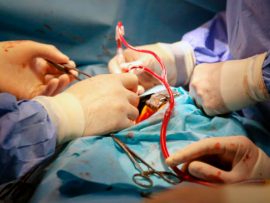Abstract Background The outcome of open-heart surgery for patients with liver cirrhosis (LC) varies widely, indicating multifactorial influences on liver injury after cardiopulmonary bypass (CPB). Methods This observational single center..
Lire la suiteAbstract Introduction and objective Children admitted to the pediatric intensive care unit after cardiovascular surgery usually require treatment with antibiotics due to suspicion of infection. The aim of this study..
Lire la suiteAbstract OBJECTIVES Some patients who undergo continuous-flow left ventricular assist device (CF-LVAD) implantation require concomitant procedures that can be performed with or without cardiac arrest under aortic cross-clamping (AXC). Procedures..
Lire la suiteAbstract Thromboelastography is increasingly utilized in the management of bleeding and thrombotic complications where heparin management remains a cornerstone. This study assessed the feasibility of the cartridge-based TEG® 6s system (Haemonetics..
Lire la suiteIntroduction Identifying patients who are ready for weaning and liberation from veno-venous extracorporeal membrane oxygenation (ECMO) is challenging in clinical practice. Compared to the several trials addressing the safety and..
Lire la suiteAbstract Background Extracorporeal membrane oxygenation (ECMO) is a life-saving modality used to manage cardiopulmonary failure refractory to conventional medical and surgical therapies. Despite advances in ECMO equipment, bleeding and thrombosis..
Lire la suiteAbstract Background Serum lactate and central venous oxygen saturation (ScvO2) are commonly used and commonly recommended as markers of tissue oxygenation in shock states. Medical literature has both explicitly stated..
Lire la suiteAbstract Background: Isolated limb perfusion (ILP) is a treatment option for malignancies localized to an extremity and is performed by surgical isolation of the limb which is connected to an extracorporeal..
Lire la suiteAbstract Background Extracorporeal carbon dioxide removal (ECCO2R) is a promising technique for the management of acute respiratory failure, but with a limited level of evidence to support its use outside..
Lire la suiteAbstract Objectives To analyse the effect of the implementation of a transcatheter aortic valve replacement (TAVR) and multidisciplinary heart team programme on mortality in severe aortic stenosis (AS). Methods A retrospective, observational..
Lire la suiteIntroduction In the last decade, primarily following the H1N1 pandemics [], the extracorporeal respiratory assist is increasingly used [, ]. The acronym “ECMO”, i.e., ExtraCorporeal Membrane Oxygenation, is, however, somehow misleading..
Lire la suiteAbstract There is evidence that, in adult cardiac surgical patients undergoing on-pump procedures, tranexamic acid (TXA) dose-dependently increases the risk of convulsive seizure (CS). We aimed to investigate whether a..
Lire la suiteAbstract Objective Investigate important clinical and operative variables associated with increases in cardiac troponin T (cTnT) as indicators of myocardial injury after coronary artery bypass grafting (CABG). Design Prospective cohort..
Lire la suiteAbstract Background Normothermic regional perfusion (NRP) is a novel technique that aids organ recovery from donors after circulatory death (DCDs). However, ethical concerns exist regarding the potential return of spontaneous..
Lire la suiteAbstract Extracorporeal cardiopulmonary resuscitation (ECPR) refers to the use of temporary mechanical support as an adjunct to standard CPR in patients with cardiovascular collapse. Although it is a relatively recent..
Lire la suiteAbstract OBJECTIVES Reports ranged from mixed to marginal tubing wear and spallation effects as a complication of roller pumps in cardiopulmonary bypass (CPB). Because the rollers constantly compress part of..
Lire la suiteAbstract Background Extracorporeal life support (ECLS) has become an integral part of modern intensive therapy. The choice of support mode depends largely on the indication. Patients with respiratory failure are..
Lire la suiteAbstract Supra-celiac aortic cross clamping is often utilized during aortic reconstruction for aneurysmal/occlusive disease involving the pararenal aorta. However, this may be accompanied a myriad of complications related to hemodynamic..
Lire la suiteAbstract Medical device manufacturers using computational modeling to support their device designs have traditionally been guided by internally developed modeling best practices. A lack of consensus on the evidentiary bar..
Lire la suiteAbstract Extracorporeal life support (ECLS, also known as extracorporeal membrane oxygenation or ECMO) emerged in the 1970s as a potentially useful life-support therapy for refractory cardiac or respiratory failure in..
Lire la suiteAbstract The relevance of right atrial pressure (RAP) as the backpressure for venous return (QVR) and mean systemic filling pressure as upstream pressure is controversial during dynamic changes of circulation...
Lire la suiteAbstract Intraoperative auto-transfusion with the use of cell saver systems is routinely used to reduce the rate of packed red blood transfusion in major surgery. Nevertheless some concerns have been..
Lire la suiteIntroduction To highlight and advance clinical effectiveness and evidence-based practice (EBP) agendas, the Institute of Medicine set a goal that by 2020, 90% of clinical decisions will be supported by..
Lire la suiteAbstract Background and objective Acute kidney injury (AKI) following cardiac surgery with cardiopulmonary bypass (CPB) is polyethiological clinical syndrome. During CPB haemodilution develops, which is useful in reducing the risk..
Lire la suiteAbstract Background The optimal prime solution for the cardiopulmonary bypass (CPB) circuit in adult cardiac surgery has not yet been defined. Mannitol is widely used in the priming solution for..
Lire la suiteAbstract Background Minimal invasive extracorporeal circulation (MiECC) reduces the impact of cardiopulmonary bypass during cardiac surgery on inflammation and hemostasis. Pulsatile perfusion may enhance organ perfusion and help to prevent..
Lire la suiteAbstract Minimally invasive extracorporeal perfusion technologies are based on the use of a minimally invasive extracorporeal circulation (MiECC) system. This includes a closed CPB circuit; biologically inert blood contact surfaces;..
Lire la suiteAbstract In this review the impact of cardiopulmonary bypass (CPB) on the microcirculation is discussed. The impact of conventional non-pulsatile perfusion is contrasted with the microcirculatory impact of pulsatile CPB..
Lire la suiteAbstract Background Endothelial hyperpermeability following cardiopulmonary bypass (CPB) contributes to microcirculatory perfusion disturbances and postoperative complications after cardiac surgery. We investigated the postoperative course of renal and pulmonary endothelial barrier..
Lire la suiteAbstract Utilization of extraocorporeal membrane oxygenation (ECMO) has become increasingly widespread as a bridging therapy for neonates with severe, reversible respiratory or cardiac diseases. While significant risks remain, due to..
Lire la suite




















